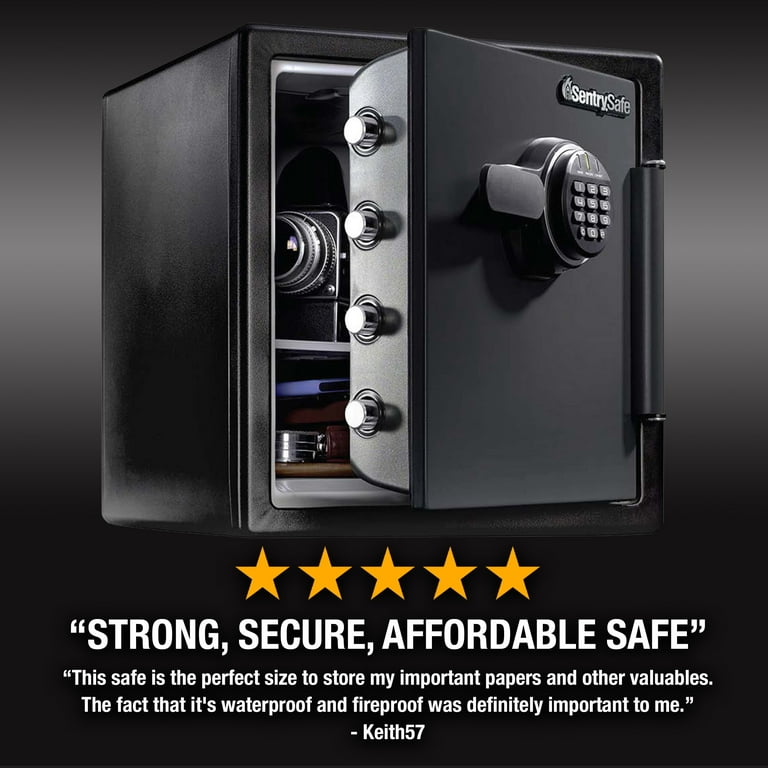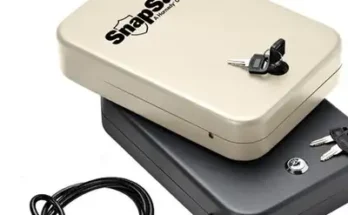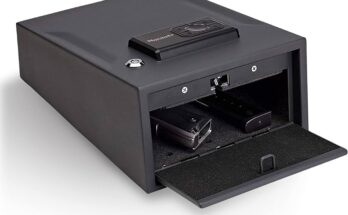Fireproof safes are effective in protecting valuable items from fire damage. They provide a barrier against heat and flames, often for a specified duration.
Fireproof safes have become an essential security feature in homes and businesses, offering peace of mind by guarding against the devastation of fire. These safes are designed with materials like gypsum, perlite, and vermiculite, which help to insulate the contents from extreme temperatures.
A good fireproof safe not only secures your valuable documents, heirlooms, and digital media but also adds an extra layer of defense, preserving these items for a predetermined amount of time at specific heat levels, usually aligned with industry standards such as the UL rating. With varying sizes and protective ratings, consumers can choose a safe that best suits their needs, ensuring that critical belongings remain safeguarded in the event of a fire.
The Quest For Protection: Why Fireproof Safes?
Homes and businesses face the real threat of fire. Precious items need protection. Loss is not an option. Fireproof safes stand as guardians. They protect against the cruel grasp of flames. Safety becomes a priority. Secure your treasures, your hard work, your heritage. Enter the world of fireproof safes. Discover their value and reliability.
Valuables At Risk: A Reality Check
Think of everything dear to you. Photos, important documents, heirlooms, even cash. Each tells a story, holds a memory, represents a milestone. Now imagine losing them all in an instant. Fires do not pick a time. They strike, leaving sorrow behind. Safeguarding valuables goes beyond locking them away. It demands a shield against heat, against destruction. A fireproof safe is that shield.
- Every year fires cause countless losses.
- Fires don’t wait for you to be ready.
- Safes preserve what’s irreplaceable.
Rise Of Fireproof Safes: A Brief History
Fireproof safes have a storied past. Their tale begins with tragedy and need. Early safes were strong but not fireproof. Fires claimed many valuables. Then, innovation sparked change. New safes withstood flames. The first modern designs emerged in the 1800s. They combined layers of steel and concrete to resist heat. This created a sanctuary for valuables.
| Century | Innovation | Impact |
|---|---|---|
| 1800s | Steel and concrete layers | Birth of fire resistance |
| 1900s | Improved locking mechanisms | Enhanced security |
| 2000s | Advanced fireproofing materials | Superior protection |
Today, fireproof safes are high-tech guardians. They use materials like gypsum and perlite. These materials shield against heat. They stand tall in fiery trials. History taught us well. Now, we store our treasures with confidence.

Credit: www.amazon.com
Dissecting The Term ‘fireproof’: Levels Of Resistance
When we talk about ‘fireproof’ safes, it’s not a one-size-fits-all definition. The term ‘fireproof’ might suggest that a safe can withstand any fire, but the truth is more nuanced. In reality, safes come with different levels of fire resistance. Understanding these levels is key to choosing the right safe for protecting valuable items against intense heat.
Fire Ratings Explained
Fire ratings are the guideposts used to measure a safe’s ability to protect contents during a fire. These ratings indicate how long a safe can endure high temperatures. Ratings often start at 30 minutes and can extend to several hours. An accredited laboratory, such as Underwriters Laboratories (UL), typically conducts the tests. They heat the safe to extreme temperatures to see how it holds up. Ultimately, a fireproof safe’s rating will determine if your valuables stand a chance during a blaze.
- UL 72 Class 350: Safes can withstand 350°F internally when outside is 1700°F.
- UL Class 150: The interior remains below 150°F in the same conditions.
- UL Class 125: The inside temperature stays under 125°F, ideal for electronic media.
Materials Matter: What Goes Into A Fireproof Safe
The composition of a fireproof safe is what gives it the prowess to protect your items. Manufacturers commonly use thick steel and composite materials to absorb and deflect heat. Let’s dive into what a robust fireproof safe typically features:
| Component | Function |
|---|---|
| Insulation | Protects from heat and fire damage. |
| Steel Walls | Forms a durable barrier. |
| Door Seals | Expands to seal edges during high heat. |
| Locking Mechanism | Secures items against high temperatures. |
In short, a safe labeled ‘fireproof’ is not indestructible, but designed to offer a specified degree of protection in a fire. The combination of fire ratings and construction materials determines just how effective a safe will be when things heat up.
Real-world Performance: Fireproof Safes In Action
Anecdotes and consumer experiences often shed light on the true effectiveness of fireproof safes amid calamities. These robust containers promise to guard valuables against searing flames. But how do they hold up beyond lab simulations and manufacturer claims? Let’s explore this through real user stories and expert analyses.
Testimonials And Case Studies
Strong evidence comes from those who have witnessed a fire’s wrath firsthand.
- Survived a blaze: Several customers report safes intact after enduring extreme temperatures.
- Protection duration: Testimonials confirm the advertised fire resistance time.
- Content condition: Valuables within are frequently found undamaged, from documents to digital media.
Case studies from renowned manufacturers often demonstrate successful safeguarding of possessions in blazing infernos.
| Case | Fire Intensity | Safe Performance |
|---|---|---|
| Home Fire | High | Contents Protected |
| Office Fire | Medium | Minimal Damage |
Limitations And Vulnerabilities
Understanding the constraints is vital.
- Fireproof safes provide temporary protection.
- Temperature caps: Beyond certain points, protection levels dip.
- Seal integrity: Over time, seals may degrade, compromising performance.
Experts highlight the importance of realistic expectations. They emphasize regular maintenance checks, proper installation, and awareness of a safe’s specific limitations regarding fire types and durations.
Choosing The Right Safe: Features To Consider
When choosing a fireproof safe, pinpointing the perfect features is key. Think of what you plan to protect. Is it documents, digital media, or valuables? The ideal safe guards these without a hitch.
Size And Capacity: Matching Your Needs
Size matters when it comes to safes. A snug fit for items ensures they stay protected. Here’s a snapshot of how to match safe size to your storage needs:
- Assess the volume of what you’ll store. Count documents, gadgets, and valuables.
- Consider future acquisitions. A little extra room accommodates new items.
- Measure your space. The safe should fit your chosen spot at home or in the office.
| Safe Size | Typical Use |
|---|---|
| Small | Passports, cash, small documents |
| Medium | Laptops, larger documents, small valuables |
| Large | Multiple items, folders, electronic devices |
Lock Mechanisms And Security Enhancements
Locks secure your belongings. A robust lock keeps intruders out. Each type offers different levels of security. Understand the lock types:
- Mechanical locks are sturdy and hack-proof. They need no batteries.
- Electronic keypads offer quick access. Change the code for extra safety.
- Biometric locks use fingerprints. They provide fast, unique entry.
Enhancements boost these locks. Reinforced doors, anti-drill plates, and alarm integrations add layers of security.
- Tamper alerts notify of unauthorized attempts.
- Multi-layer steel walls resist extreme conditions.
- Internal hinges deter outside hinge removal.
Maintenance And Best Practices For Longevity
Effectiveness of fireproof safes hinges on consistent care. Maintenance and preemptive practices stretch their lifespan significantly. Let’s explore some essential tips to keep your fireproof safe in top condition.
Routine Checks And Upkeep
Regular inspections are crucial for a fireproof safe’s longevity. Follow these straightforward steps:
- Examine the seals: Check the door seals every six months. Ensure they are intact.
- Look for damage: Search for any signs of wear and tear. Address promptly.
- Clean the exterior: Dust and wipe down the exterior with a damp cloth.
- Oil the hinges: Apply lubricant annually to prevent rust.
By keeping up with these simple tasks, you’ll ensure that your safe remains operational and effective against fire damage.
Safeguarding Against Non-fire Threats
Protect your safe from other dangers aside from fire. Here’s how:
- Moisture control: Use desiccants or a dehumidifier to prevent moisture buildup.
- Position strategically: Place the safe where it’s less likely to face floods or falls.
- Keep it locked: Always lock your safe to deter theft and tampering.
- Limit access: Only trusted individuals should know the safe’s location and combination.
Precautionary steps shield your belongings from more than just flames. They warrant the safe’s enduring protection.

Credit: www.amazon.com
Conclusion: The Verdict On Fireproof Safes
Delving into the effectiveness of fireproof safes, the discoveries are revealing. These safes stand as a shield for valuables against flames. This section concludes our exploration with a clear verdict.
Balancing Expectations With Reality
Understanding a fireproof safe’s limitations is essential. Let’s look at the facts:
- UL ratings guide us on how long items stay safe.
- Fireproof does not mean indestructible. It means resistant for a time.
- Each safe has a thermal threshold. Beyond it, contents get damaged.
An informed choice about fireproof safes aligns your expectations with the reality of their capabilities.
Investing In Safety: Worth The Price?
Assessing the value involves several factors:
- Evaluate the worth of what you’re protecting.
- Consider the cost of losing these items in a fire.
- Compare safe prices and features.
Secure storage for valuable items often justifies the investment in a quality fireproof safe.

Credit: www.walmart.com
Frequently Asked Questions On Are Fireproof Safes Effective?
How Effective Are Fireproof Safes In Emergencies?
Fireproof safes are designed to endure high temperatures during fires, protecting contents for a specific period. Usually, they are rated to resist heat for 30 minutes to 2 hours, depending on the model. This ensures important documents and valuables remain secure during most residential fires.
Can Fireproof Safes Withstand Any Fire Temperature?
Fireproof safes have specific fire rating levels that determine the maximum temperature they can withstand. Most can handle temperatures up to 1,700 degrees Fahrenheit. Beyond their rated limit, the contents could be at risk. It’s important to check the safe’s UL rating for exact specifications.
What Items Are Best Protected In Fireproof Safes?
Fireproof safes are ideal for safeguarding critical documents like passports, legal papers, electronic data, and small heirlooms. These safes are also useful for protecting currency, jewelry, and keys that might be necessary for post-emergency access or recovery efforts.
Are All Fireproof Safes Also Waterproof?
Not all fireproof safes are waterproof. However, many models offer a combination of fireproof and waterproof features for comprehensive protection. Check product specifications for waterproof ratings, as some safes can protect against flood damage for a certain depth and duration.
Conclusion
Fireproof safes offer critical protection for valuables against heat and fire damage. While not entirely invincible, they provide essential security in emergencies. Selecting the right model is key, blending UL ratings with personal needs for optimal safeguarding. Trust in fireproof safes; they’re an investment in peace of mind.



